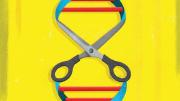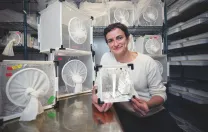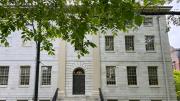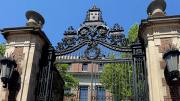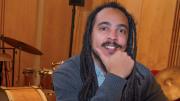The powerful new gene-editing system Crispr-Cas9 “is a revolutionary tool,” says Kevin Esvelt; he and many other scientists already consider it one of “the pillars of molecular biology right now.” A technology-development fellow at Harvard’s Wyss Institute, Esvelt has worked to refine this technique that allows researchers to make precise edits at multiple locations in the genomes of all kinds of living things, including plants and animals.
Crispr-Cas9’s function in bacteria as a kind of primitive immune system against viruses was first described in 2012 by Jennifer Doudna, Ph.D. ’89, of the University of California, Berkeley, and French scientist Emmanuelle Charpentier, now director of the Max Planck Institute for Infection Biology in Berlin. In early 2013, Winthrop professor of genetics George Church and Feng Zhang, of the Broad Institute of Harvard and MIT, separately described the first uses of Crispr-Cas9 to edit human cells. Its subsequent rise as a gene-editing tool has been swift.
The system consists of two parts: Crispr, an RNA-guided targeting system, and Cas9, a protein that acts like a pair of molecular scissors. The Crispr portion carries a RNA-guided sequence that directs Cas9 to precisely cut any DNA sequence that matches the target. If scientists then inject a replacement DNA sequence similar to the excised segment, the cell’s own repair mechanisms will stitch the new sequence into the cut. Researchers can easily change the RNA guidance system to target any stretch of DNA, and supply a new, altered sequence that will be placed in its stead.
Crispr-Cas9 occurs naturally in about half of all bacteria. The Crispr portion (the name is an acronym for the Clustered Regularly Interspaced Short Palindromic Repeats that Doudna and earlier researchers observed in bacteria) carries RNA sequences for viruses that commonly invade the bacterial cell. When that happens, Crispr guides the Cas9 protein to cut out, and thereby disable, the viral DNA. The Crispr guidance system can carry target sequences for many different viruses that attack bacteria, thus providing functional immunity (500 is the maximum number of sequences observed thus far in nature).
This ability to carry and target many different sequences at once is an additional reason that Crispr-Cas9 is such a powerful tool for editing the genomes of plants and animals, Esvelt explains. Because it can change multiple genes at once, Crispr-Cas9 can be used to change complex traits that are controlled by multiple genes.
In the autumn of 2013, Esvelt became the first person to realize that, if inserted into germline cells (those passed from one generation to the next), the Crispr-Cas9 gene editing system, including its targets and replacement sequences, would be passed fully intact from one generation to the next, autonomously editing the DNA of generations of offspring ad infinitum, thus pushing genetic changes through entire populations of organisms. The idea had been floated a decade earlier by British geneticist Austin Burt, but without tools to execute it, remained a theoretical possibility only. With Crispr-Cas9, Esvelt realized, all that had changed. He alerted Church, his academic adviser, and contacted Burt. And then immediately, before undertaking a single experiment, he and Church, together with like-minded scientists, began to develop safety protocols to guard against the possibility of an accidental release of the technology into the wild. The gene drive had become a reality.
